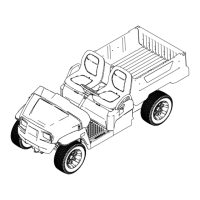T ransporting the
Lithium-Ion Batteries
The US Department of T ransportation and
international transportation authorities require that
lithium-ion batteries be transported using special
packaging and only be transported by carriers certied
to haul them. In the US, you are allowed to transport
a battery when it is installed on the machine as
battery powered equipment, with some regulatory
requirements. Contact the US Department of
T ransportation or the appropriate government body in
your country for detailed regulations on transportation
of your batteries or the machine with the batteries
equipped.
For detailed information on shipping a battery , contact
your authorized T oro distributor .
Understanding the
Lithium-Ion Battery Charger
Connecting to a Power Source
DANGER
Contact with water while charging the
machine could cause electric shock, causing
injury or death.
• Do not handle the plug or the charger with
wet hands or while standing in water .
• Do not charge the batteries in the rain or in
wet conditions.
T o reduce the risk of electric shock, this charger has a
3-prong grounded plug (type B). If the plug does not
t into the wall receptacle, other grounded plug types
are available; contact an authorized T oro distributor .
Do not change the charger or the power-supply-cord
plug in any way .
Important: Check the power supply cord
periodically for holes or cracks in the insulation.
Do not use a damaged cord. Do not run the cord
through standing water or wet grass.
See Figure 27 for power source requirements.
decal140-4590
Figure 27
1. Plug the power-supply cord into the machine
charger outlet ( Figure 28 ).
W ARNING
A damaged charger cord can cause an
electrical shock or a re.
Thoroughly inspect the power supply
cord before using the charger . If the cord
is damaged, do not operate the charger
until you obtain a replacement.
g424855
Figure 28
1. Charger outlet
2. Insert the wall plug end of the power-supply cord
into a grounded electrical outlet.
28

